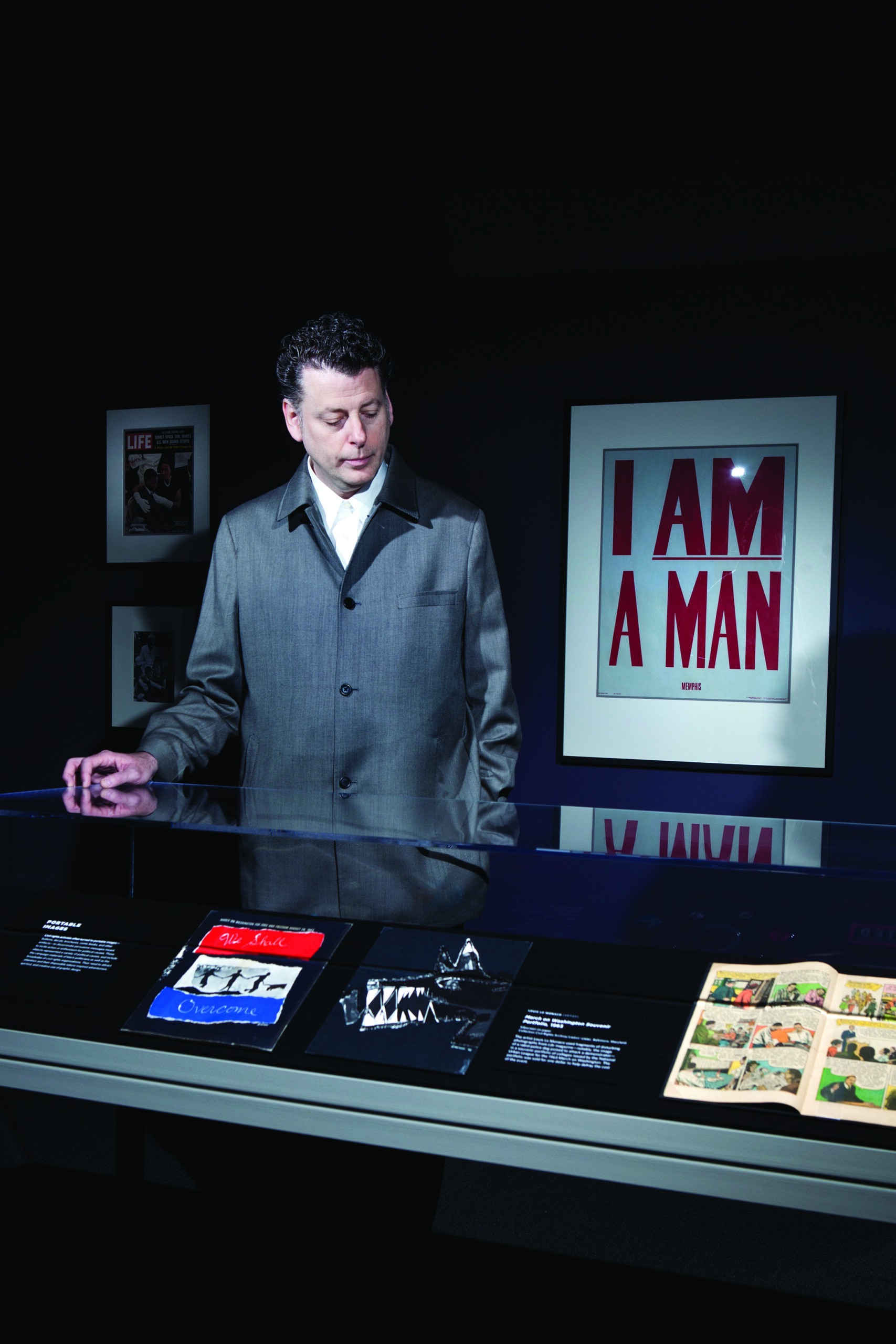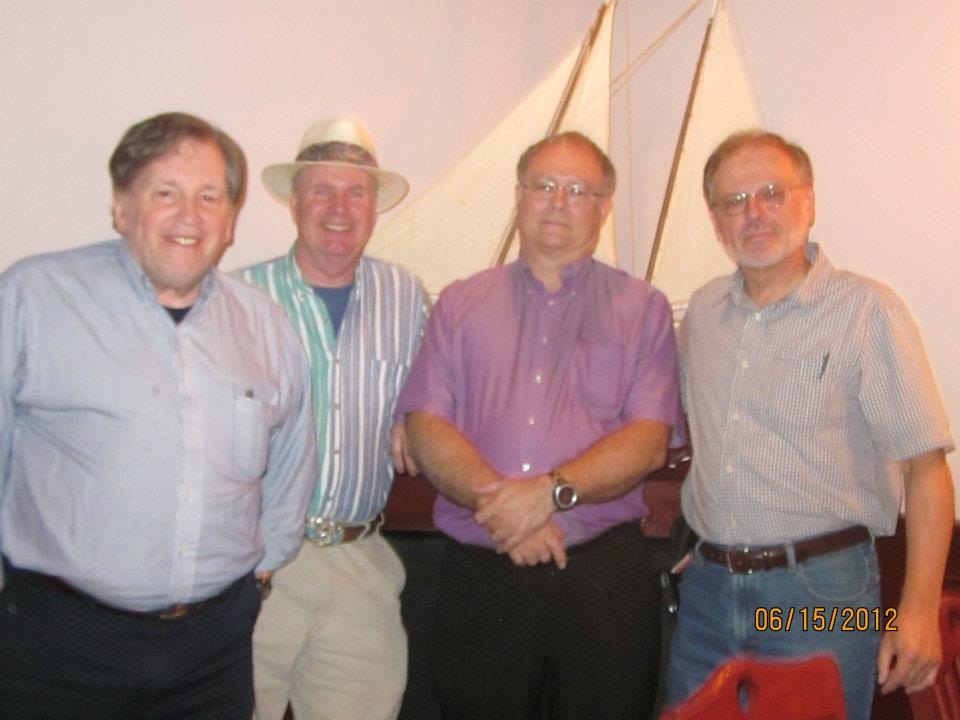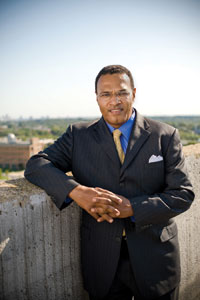Whether he is enlightening readers on the nuances of photographs with his posts on “The Lens” blog at The New York Times, curating an exhibit such as For All the World to See, or testing the boundaries of memoir and cultural criticism (as he did with his book White Lies: Race and the Myths of Whiteness), you can count on Maurice Berger to be at the forefront of American culture’s engagement with its history and visual culture.
Berger is research professor and the chief curator at UMBC’s Center for Arts, Design and Visual Culture (CADVC). He is also a consulting curator at the Jewish Museum in New York City. He took a B.A. from Hunter College and his Ph.D. from the Graduate Center at the City University of New York. Berger’s range of activities is prolific – including cultural criticism in books and articles, curating exhibits and filmmaking. (His short film, Threshold, was screened in May at the Whitney Biennial.)
Berger’s interests range widely, and he has written about and organized exhibits taking in the grand sweep of 20th Century U.S. culture and its artistic movements. Yet it is his eagerness to tackle some of the thorniest issues in American race relations that has catapulted him to greatest prominence. Early in his career, Berger was a key voice in the debate over whether art museums were perpetuating racism (including a 1990 piece in Art in America – “Are Art Museums Racist?”). And his memoir, White Lies, dissected his own experience and attitudes about race while simultaneously conducting a rigorous yet empathetic analysis of the entire fraught concept of racial categories. (The New York Times called the book “startlingly original.”)
As Berger receives recognition and rewards for For All the World to See and his other work in cultural research (including an Emmy Award nomination for his work on a PBS Sunday Arts story about For All the World to See and the “Outstanding Exhibition in a University Art Museum 2010″ from the Association of Art Museum Curators), he is moving forward on new projects that include three future exhibits that will also appear at the CADVC in coming years: a 25th anniversary exhibit for the center and a new exhibit tracing the influence of modernism on the birth of American television.
Berger talked with UMBC Magazine recently about his career and those future exhibits. He is particularly excited about the opportunity to reach even wider audiences through his posts on “The Lens” blog.
“It’s an opportunity to explore the story of race in America through photographs,” Berger says. “The enormous audience that the Times affords will provides me with a broad, international platform to explore the fraught, but also vital, subject of race. The response to my first piece this July, on Gordon Parks’ civil rights photographs, was extraordinary. My plan is to write an essay every other month.”
– Richard Byrne ’86
UMBC Magazine: One thing that immediately stands out to me when looking at your career is that you have spent a great deal of time questioning how race works in our institutions and in our own individual lives – as you did so eloquently with your own life in White Lies.
Maurice Berger: My interest in questioning institutional attitudes about race goes back to my childhood, to growing up in an environment in which very few white people lived or worked. I saw how the system operated very early in life. I could walk around a department store and not be followed by security guards, for example, while my black friends would walk around the same stores and be followed. Even early on, I understood.
I also saw teachers who would treat black students quite differently from the way they treated me – since I for most of my early education I was one of the few white kids in the schools I attended. Even from that early vantage point, I could see things were not quite equal – and that institutions had certain kinds of collective attitudes.
I became a professor at Hunter College in the early 1980s. (First thing you know I was back as a professor at my undergraduate college.) And even there, I found it interesting that I had only one African-American colleague – and he was an artist, not an art historian. I had never heard a black artist discussed in any of my art history classes as an undergraduate or a graduate student, perhaps with the exception of a mention of Jacob Lawrence in passing.
Given that my field is 20th century American art and culture, that’s pretty amazing. And my teaching career began just about the time I began publishing in 1980. So at that point, I started to see that there was a problem. And I realized that I had to do something about it as an art historian and a cultural historian (as well as a responsible human being).
As you see with White Lies, I’ve always been thinking about these issues. But the reason that the memoir was published in 1999 and not in 1989 was that I wasn’t ready. One of the hardest things that I have accomplished as a writer was to write autobiographically. It brings up memories. It brings up things you’d rather not think about. It exposes you in a certain way. And then when you publish it, you rightfully (in an almost paranoid way) feel that what you’ve published isn’t a piece of writing, but you. If it is rejected, then you are rejected.
The good news is that White Lies was widely reviewed and almost every review was very positive and some were raves (it even was nominated for several awards). The book remains in print and it still has a relatively wide audience, especially among young people and in academia. So it turned out all right, but it was very scary at the time.
UMBC Magazine: When I went back and read the profile of you that The New York Times published shortly after White Lies came out, one of the things you noted was that readers’ responses to the book were very different and very personal. Telling your own story seemed to compel readers to share their journeys.
Berger: I think with race – and attitudes and behavior around race – if you want to change, it has to begin with personal honesty. I’ve always said that if people can’t see the problem and acknowledge the problem, then you can’t get past it.
Remember, so much of what I am writing about in White Lies is not just the domain of white supremacy in the South, it is also the domain of white liberals and leftists. Racism is not limited to conservatives or Southerners. We all need to collectively – and, even more important, intimately and privately, where there is less room to be rebuked or embarrassed – assess ourselves.
And that’s the point of White Lies. And it’s also part of the apparatus of For All the World to See. All the images and stories in the exhibit invite you to think about your own attitudes. Or, if you are older, to reflect on when you yourself first saw these images. How did they make you feel? Did they help change your attitudes? Did they awaken you to the reality of racism and segregation and the problems they presented for the country?
UMBC Magazine: Do you remember the moment when you had the vision for For All the World to See? Was there a particular image that set you in the direction you took in the exhibit?
Berger: It’s a funny thing to think about, because I can usually answer that question when someone asks it about a particular project. It’s not that I don’t remember with regard to For All the World to See, but the thing that’s different with this project – and possibly why it has been so well received and reached so many people (almost one million to date) – is that for the first time, in a dynamic and comprehensive way, I have been able to put together my two primary cultural research areas. The first is the history of American race relations – the issues of race and racism and the analysis of them.
The other interest I have been able to bring to bear on For All the World to See is how visual images manipulate, inspire, infiltrate and integrate ideas in American society and culture. As a cultural historian, my focus is on visual culture and how it operates in society.
So maybe that’s why I can’t remember a particular image. This project has been so natural. It’s the culmination of the two things I have been most driven to do and to explore, two things that have preoccupied me for most of my life.
UMBC Magazine: One of things in the exhibit that impressed me greatly was the way that the iconic journalistic images of the political and moral battles of the Civil Rights movement are juxtaposed and connected with lesser-known visual images created to build self-esteem in the African-American community and portray life in that community as very much like that in white America.
Berger: Until this project most exhibitions of Civil Rights history or Civil Rights culture focused on one particular thing: The way that photographers, and mostly well-known photographers or photojournalists (many of them white), documented the struggle for Civil Rights. And what that has meant is that these exhibitions are dominated by images of the events that we have come to associate with the Civil Rights movement: the protests, the marches, conflagrations, violence, poverty, and all the outward vestiges of racial segregation and prejudice. And that is what Civil Rights imagery has come to mean for most Americans.
For All the World to See argues that the Civil Rights movement is not just about who documented it, or the story of these protests and other events. It proposes that images of all kinds—from film and television to picture magazines and advertising (to quote the great, late photographer Gordon Parks) were employed by African Americans as a “weapon” against racism in America.
Thus, the story of the visual culture of the civil rights movement is far more complicated than we realize. For as [Supreme Court Justice] Thurgood Marshall said, the struggle for civil rights was not just about the protests or the legal cases, but also about African-American morale and legitimacy. How do you inspire a community that is continually beaten down by the realities of racism to rise up and keep the faith? How do you convince white people that the habitually negative and subservient images of black Americans in the culture at large were wrong and immoral? And, perhaps most important, how do you bolster the morale of African Americans scarred by racism and segregation? How to you reflect back to them images that showed the wholesome nature of black life, despite the onslaught of racism in myriad forms?
And, just as importantly, while much of white America did not perpetuate Jim Crow segregation, most white people remained uninformed about the African American community and the pervasive reality of racism, particularly their own. Once again, visual culture played an important role in educating white Americans about the reality of race and racism in America. Affirmative images of black people served as a very important aspect of the movement. These images not only bolstered the morale of African Americans in the face of withering prejudice, but also reminded white Americans that black people led the same kinds of lives and had the same kinds of family relationships as their white counterparts. Such imagery, in other words, powerfully appealed to the empathy of white readers and viewers.
UMBC Magazine: What’s next for you as a cultural historian and curator?
Berger: I am working on a number of projects simultaneously. Much of what I’ll continue to do revolves around the question of American race relations and the study of racism and segregation in America. I am working on another large Civil Rights exhibition and book, though it’s still a long way off, and it will be at CADVC in 2017: The Site of Memory: Reimagining the History of Civil Rights. Plus, I will be contributing regularly to the “Lens” blog at The New York Times, which I am very excited about. Writing for the Times gives me a broad, international platform through which I can share my ideas about race in America (and hopefully make a difference, even change minds and hearts).
I’ve also had a long term relationship with The Jewish Museum, where I have worked on a number of projects over the past twenty years. Last December, shortly after she came on board, newly hired Jewish Museum director Claudia Gould asked me to join the museum as consulting curator. She felt that my work and my point of view were a good fit. Over the past eight months, we’ve been working together with our colleagues to reshape the mandate of the museum and move forward in a bigger and more dynamic way.
I am also working on a collaborative project with The Jewish Museum and the CADVC, an exhibition and companion book (the latter to be published by Yale University Press): Revolution of the Eye: Modern Art and the Birth of American Television. It’s the first major research project in a long time that does not focus on the story of American race relations It tells the extraordinary story of the birth and rise of American television from the 1940s to the 1960s, and how its executives and writers and producers – most of whom were Jewish – embraced the modernist avant garde as a source of inspiration, aesthetics, and ideas. Television pioneers such as Rod Serling were actively looking at surrealism; Ernie Kovacs was embracing both Dadaist and surrealist sensibilities in his work. And CBS employed some of the top modern artists and designers of the period to help them develop what was at the time one of the most progressive design campaigns of any American company.
The exhibit also argues that television was born not just in the spirit of entertainment, some of it frivolous, but also with deeply held artistic and intellectual concepts and ambitions. This story is virtually unknown to most Americans (and even most art and cultural historians).
Yet, even an institution as famous as the Museum of Modern Art (MOMA) got into the act of producing, curating, and analyzing the medium. In the 1950s, the museum established the MOMA “Television Project,” dedicated to exploring the creative possibilities of television and producing content that sold the gospel of modern art and established the importance of modern artists. We will actually be working with MoMA to produce an array of public programs and TV screenings around the exhibition.
Ultimately, and despite the commercialism of it all, art has always been present on television. The point of “Revolution of the Eye” is that art is in the medium’s DNA.
I am also proud to say that I will also be curating CADVC’s 25th anniversary exhibition, which will open in 2014. So at UMBC alone, over the next five years, three of my projects will premiere.
– Return to Staging the Struggle
Tags: Fall 2012




